The stars have throughout history been fascinating objects of study. From the ancient Greeks, to the modern day astronomers who continually search the stars for other planets and galaxies.
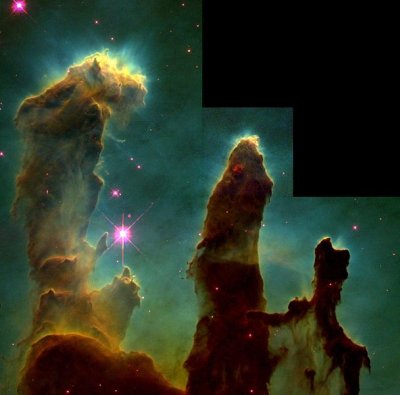
One of the Hubble telescope's most famous images showing stars forming in the Eagle Nebula. (Photo credit: Wikipedia)
The universe is constantly expanding, and changing, thus every time an astronomer looks into his telescope he may see something there that wasn’t there the day before! In a place full of so much wonder and so many unknowns, it’s no wonder there are tons of facts about stars.
Here are 25 fascinating facts about stars:
1. Many stars you look at in the night sky seem like single, distant glimmer of light. However that is not the case. Most stars you see in the night sky are actually two star systems, or binary star systems. They are so far away however that they just appear as one speck of light.
2. Stars go through many phases of life, much like other organic beings. When a star is dying, it turns into a “white dwarf”, when the star uses up all of the chemicals required for its nuclear fusion reaction, it will fuse a large clump, which will emit white light until it finally darkens for good.
3. Before a massive star goes into a white dwarf phase however, it undergoes an incredible chain reaction in which it burns through the rest of its fuel at a dramatic pace and explodes due to the speed of the reaction. This reaction is known as a supernova.
4. If a star is massive enough, after it goes supernova it can actually turn into a massive, gravity and light eating black hole.

The SN 1994D supernova in the NGC 4526 galaxy (bottom left) (Photo credit: Wikipedia)
5. Contrary to popular belief a black hole does not “suck” in the objects around it. Due to their incredible mass, according to Einstein’s general theory of relativity, they actually bend space in such a way that everything within their gravitational field is pushed towards it. A black hole’s gravitational field is so strong that even light cannot escape it.
6. If a star has enough mass, it will burn up much like a white dwarf. Instead of fading away however, it will go into a state of degeneration, these stars are rare and are called “neutron stars”.
7. Neutron stars are extremely easy to recognize. Opposed to white dwarves they are easy for astronomers to spot through telescopes because they bend the light around them, which allows them to be seen easily through infrared telescopes.
8. There are some stars that are 100 times more massive than our Sun. These stars also can output about a million times more energy than our sun, while still maintaining the same radius.
9. Eta Carinae is one of the largest stars in the known galaxy, it is designated as a hyper-giant.
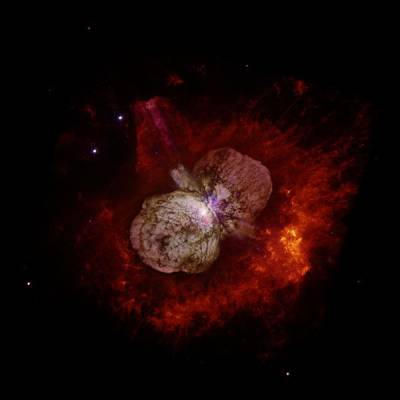
Eta Carinae and the surrounding bipolar Homunculus Nebula seen from the Hubble Space Telescope (Photo credit: Wikipedia)
10. Another hyper-giant star is designated as Pistol, it shines even brighter than Eta Carinae, at about 10 billion times more than our sun. It emits such high amounts of radiation that scientists have already declared it impossible for anything to live in such a system.
11. The closest observable star is Sol, or as it’s more commonly known, the Sun. Although it is around 150 kilometers away, there are billions of stars just like our Sun out there in the galaxy.
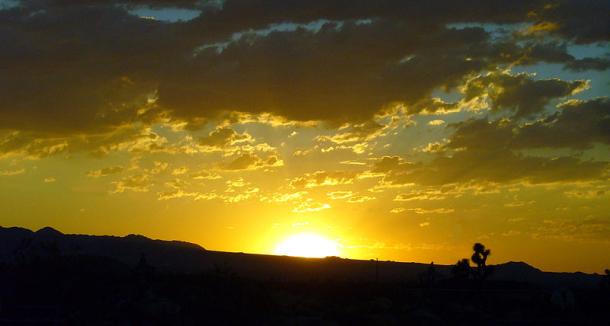
Our nearest star, as seen from earth (Photo credit: Wikipedia)
12. The distances involved in measuring how far away a star is are immense. Consider that the closest star to Earth is approximately 4.2 light years away. It would take about 70,000 years in our fastest space craft to reach it.
13. There are approximately 400 billion stars in the Milky Way galaxy alone.
14. On a clear night, you cannot see even a fraction of these stars. However during a clear night, in the country, with the naked eye you can see up to 19,000,000,000,000,000 miles away, very easily.

The Milky Way as seen above the Paranal Observatory. You can also see Jupiter (the brightest object) and the star Antares. (Photo credit: Wikipedia)
15. Every single star has almost the exact same chemical composition. The nuclear fusion reaction which occurs in each star is identical in each star, which requires hydrogen which turns into helium. As the hydrogen burns it collapses and forms a center mass due to gravitational pull of the heavier helium.
16. The original materials that make up all stars within the galaxy were formed during the Big Bang.
17. Stars are constantly undergoing changes in pressure and chemical makeup. However at all times, they are in perfect balance. Consider that if stars didn’t have balance, they would continue collapsing inward until they ran out of fuel. They do not because they are constantly creating a perfect balance of inward and outward pressure, and hydrogen and helium.
18. The most common type of stars within the universe are red dwarves. This stars are common due to their low mass, and the fact that they live for a very long time before turning into white dwarves.
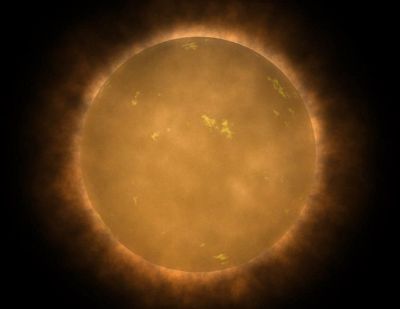
An artist's conception of a red dwarf (Photo credit: Wikipedia)
19. The color of a star can tell an observer a lot of things, as the color of a star can show give an idea of how much mass it has, luminosity and other interesting data.
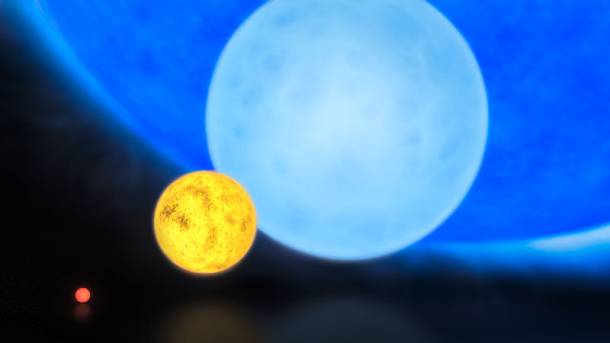
Comparison of stars (left to right): red dwarfs, the sun, blue dwarf, and the largest star in the universe.
20. The coolest stars in the universe are red, and they sit at around 3,500 kelvin (a special temperature measurement used for stars).
21. Opposite to that, the hottest stars are blue due to their incredible mass and the amount of chemical reactions occurring within them. They burn at around 6,000 kelvin.
22. Despite many peoples claims of there being “green” stars, there are no stars in the known universe which are green. A green star is usually a side effect of a looking through a telescope on a certain wavelength.
23. There are exceptions to even this rule, as when certain stars reach the end of their life they increase their fusion reactions by about 1000, which can lead even some red stars to burn at the same rate as a blue star.
24. The stars that have the shortest life spans are the most massive. They lend their mass to a high density of chemicals, as such they burn their fuel much quicker than smaller stars.
25. Despite how often stars are claimed to “twinkle” this is not true. The twinkling effect is merely the light from the star passing through the Earth’s atmosphere, and it is merely deflecting the light before it reaches your eyes.